“Life is full of homages to Tati”*
originally intended as part of the 1967 in Film Blogathon
hosted by The Rosebud Cinema and Silver Screenings
(and then I got horribly sick—children are Petri dishes of contagion
—so it’s only, uh, three weeks late)
Anyway, check out the plethora of great posts from the Blogathon!
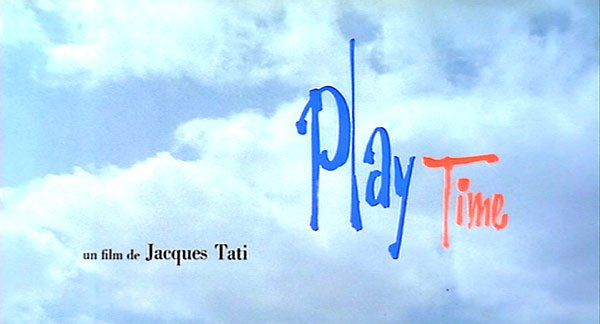
French filmmaker Jacques Tati was only able to make six feature-length films, but each film, right from the beginning with “Jour de fête” (1949) and “Les vacances de Monsieur Hulot” (1953), has the mark of comic genius. Tati’s films are immediately recognizable for their use of sound, their democracy of action, and lack of any significant plot. And especially for Tati’s exuberant gags. “Playtime” (1967) is generally regarded as the director’s masterpiece. Originally running around 2 ½ hours, Tati eventually edited it down to just under two (and at least some of that edited footage is still missing).
Tativille Is a Place
“Playtime” is about people and their urban environment: buildings, technology, and other people. Tati was interested in people and their experience of space, and he was worried about how certain kinds of modern spaces were changing the way people interacted. The film takes pleasure in mocking our ability (or lack thereof) to thrive in the structures we’ve created and to manage the gadgets we fetishize.
But there is always a gentleness to Tati’s mockery, much like Buster Keaton’s, a clear influence. And like many silent film artists, Tati turns his environment into art by manipulating how people and objects interact with each other. To make the world look and work the way he wanted it to, the director constructed his own town, dubbed “Tativille,” outside of Joinville, Haute-Marne, France. (Unfortunately, manipulation on this grand a scale bankrupted him when the picture didn’t do well at the box office.)
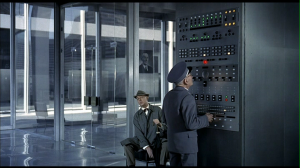
Tativille looks suspiciously similar to our world, but like the obsessively constructed worlds in Vladimir Nabokov’s novels or Quentin Tarantino’s films (two much-less gentle geniuses), it is plainly not the real world. Each object, each line and curve has the potential to come to life at any moment. Everything (and everyone) is a prop in a Tati film, which may sound dehumanizing. But the overall effect of every Tati film is to humanize its setting and give its inhabitants (they don’t often rise to the level of characters) a space to be human—to socialize and experience pleasure.
Plotless Pleasures
By the end of a Tati film, no matter how many mistakes have been made, no matter how much destruction has taken place, you are likely wishing his world were the real world. During the last 20 – 30 minutes of “Playtime,” the drably-colored, antiseptically-modernist environment breaks into a carnival-like chaos, with brightly colored decorations, a lot of drinking and dancing and socializing across classes and languages.
Beyond this shift, there is no plot to speak of—an American tourist named Barbara arrives in Paris with a tour group and Tati’s Monsieur Hulot has a business appointment are the closest thing to plot here. There are, however, recurring individuals (and patterns). In addition to M. Hulot and Barbara, there is the customer in the pharmacy-deli who turns out to be one of the jazz musicians at the Royal Garden nightclub, the man with whom Hulot has an appointment, M. Giffard, but keeps missing, an army buddy or two of Hulot’s, and so on.
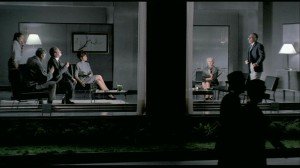
The architecture—all floor-to-ceiling glass walls and doors and endless grayish-blue cubicles—often has people on display but keeps them from interacting. Indeed, one of the film’s first gags is a worker trying to get a light from the porter of an office building, not realizing that there is a glass wall between them.
Once people are outside these constructions, or they collapse, connections are made—Hulot runs into the army buddy he saw earlier but who was stuck in traffic; M. Giffard, out to walk his dog, finally sees Hulot on the sidewalk and they walk off together. Whatever they have to discuss is beside the point; the important thing is that they’ve finally gotten in touch.
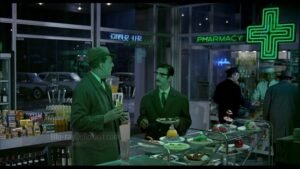
Spaces “deteriorate” in the last third of the film, creating new space more accommodating to these connections. The Royal Garden nightclub opens before it’s quite ready and the space just comes to pieces as tiles peel off the floor, waiters rip their uniforms on poorly designed chairs which are leaving marks on the backs of diners’ jackets and dresses, and finally the walls literally come down.
But, once the décor of the nightclub starts to come apart, the customers are able to mix with each other and with the workers, and to make their own music. The lengthy sequence is a justifiably famous set-piece. Similarly, the pharmacy-deli introduced in the last third of the film is a typical Tati mish-mash of spatial functions, resulting in sandwiches glowing green as they bask in the neon light of the pharmacy on the one hand while encouraging conversation and jollity on the other.


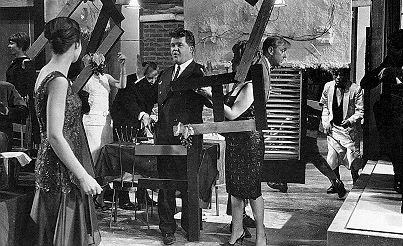
In “Playtime,” there is never just one thing going on—there is a constant symphony of activity, and not just throughout the film but throughout the screen. It was filmed in 70mm, “that grand epic format that covers the largest screens available with the most detail imaginable,” according to Roger Ebert. “Playtime” requires a big screen and rewards multiple viewings.
It was filmed almost entirely in long shot; there are no closeups. A preponderance of frames are filled with activity in each field—foreground, medium ground, and background—or in every quadrant. Often the audience must decide where to look—our attention is not always directed to the unfolding of a particular event.

The Sights and Sounds of Tativille
The soundtrack is likewise a panorama of traffic, conversations (often at a level we can’t quite hear), blips and bleeps, doors opening and closing. These noises create some of the humor and also suggest that everyday objects have developed their own personalities.
Sound was always an integral part of Tati’s cinema—doors seems to have been a special favorite, starting in “Vacances.” Which makes sense, as so much of Tati’s narrative, in all of his films, is about collapsing boundaries. And the soundscape in “Playtime” does work something like its field of vision. We hear some ambient noises in the “foreground” more loudly than they’d be in real life, directing our attention to something on screen we might not otherwise notice.
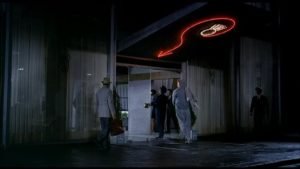
Tati loves shapes and colors, and you can tell even when he’s not using many—the interaction of shades of gray in “Playtime” are carefully orchestrated. They make the colors that do appear in the last third of the movie especially captivating.
One of the pleasures of Tativille is the patterns, the constant matching of shapes and movements. When a tiny but very important man deplanes at the beginning of the film, a tag on his suitcase flaps in a nonexistent breeze inside the terminal. Later, at the Royal Garden, the maître d’s suit tails swing back and forth as though equipped with an invisible metronome.
In the exhibitor gallery of a futuristic product expo, an absurdly statuesque woman demonstrates a pair of dark, thick-framed glasses whose lenses flip up separately, so that its wearer can apply makeup, one eye at a time. Shortly after that, we’re introduced to the owner of a firm that makes silent doors (more on this below), whose dark, thick-framed glasses later break in the middle, repeating the visual of the one-up, one-down lenses on the first pair of glasses.
It is no accident that an accident creates the same effect that some company has mass-produced and offered for sale. Accidents frequently open an avenue between previously segregated groups of people.
In Through the Out Door
One of my favorite gags in “Playtime” is the “Slam Your Doors in Golden Silence” bit towards the beginning of the film. Hulot walks through the expo’s booths which advertise the latest in mod cons.

Each and every one of these is, of course, a ridiculous contraptions that no one needs. There is the garbage can shaped like an ionic column. There is the desk lamp that offers different colored lights. There is the vacuum cleaner with headlamps attached. (Wait a minute…I have one of those—though in my defense, the lights on mine are not the size of grapefruit). All these objects make delightful burping and metallic grunting noises.
Except for the silent doors.
The doors have been made with an insulated material and whatever sound they actually made when moving or closing seems not only to have been wiped from the soundtrack but maybe replaced with a noticeable silence. (Or maybe that’s just the effectiveness of the bit.)
A faux Hulot—the film is filled with them—mistakes the silent door exhibit for an extension of an adjacent exhibitor selling office desks. While the door salesman is demonstrating the silence to a potential customer, the faux Hulot rifles through the desk, empties his pipe in the ashtray, and generally helps himself in a way most offensive to the salesman—who can’t do anything because he’s distracted by a sales prospect.
The owner of the silent door company turns up a few moments later, and his salesman complains about the man in a hat and raincoat carrying a pipe. The salesman trots off and Hulot appears. The owner (the one whose glasses split) mistakes him for the impolite not-Hulot. The set-up is at least as funny as the pay-off, when the owner berates the oblivious Hulot.
The mistaken-identity gag perhaps suggests Tati’s impatience with the popularity of the Hulot character. But the encounter is also one of several that eventually blossom into the revelry at the collapsing Royal Garden nightclub. And like the bumbling encounters that later bear fruit, the “golden silence” of the insulated doors is later replaced by the amiable cacophony of unplanned, unprogrammed conversation and music.
Towards the end of “Playtime,” Hulot is attempting to leave a small and crowded magasin with a gift for the American tourist. He maneuvers around a set of pot handles sticking into the aisle, only to be told he must go back and exit through a turnstile which now looks remarkably like…a bunch of pot handles sticking out. Hulot can’t reach her in time, but the encounter is saved by an intermediary who passes the souvenir to Barbara as she boards the bus for the airport.
“Playtime” is overflowing with little gags like these, and they are exquisite in design and the joy they take in the physical world. The greatest thing about any excursion to Tativille is that infectious joy the audience brings back with them, and how it changes the way we look at our environment.
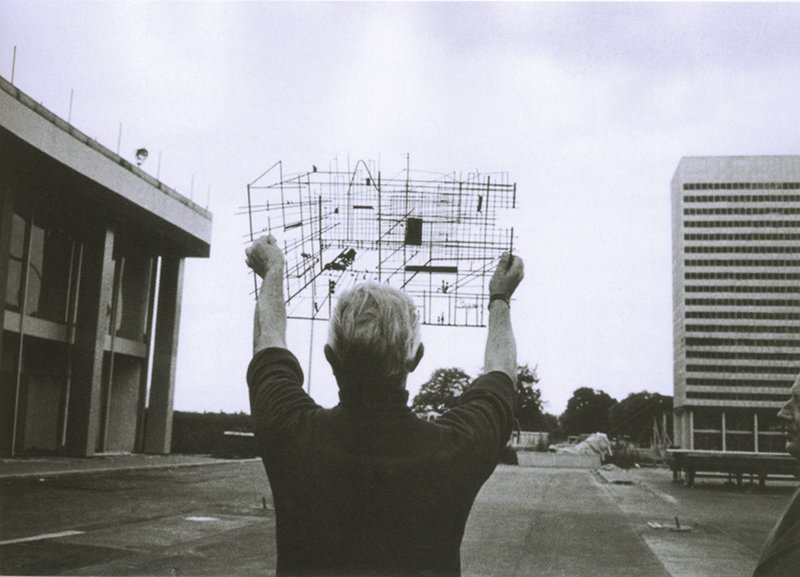
* This post is dedicated to my parents, whose anniversary is July 14, Bastille Day. *
* Michael Chion, Senses of Cinema
Other Tati Essays and Tidbits
Roger Ebert on “Playtime,” one of his Great Movies.
Le main droite de M Hulot about Tati’s collaborator, artist Jacques Lagrange, including details about his work on “Playtime,” by Kristin Thompson. (She argues elsewhere, convincingly, for the title as two words.)
Jonathan Rosenbaum’s essay on “Playtime“ from Criterion.
David Bordwell’s post on “Funny Framings” starts off with a Tati example from “Playtime.”
Dan North’s post on “Playtime”: “Modern Life is Noisy”
